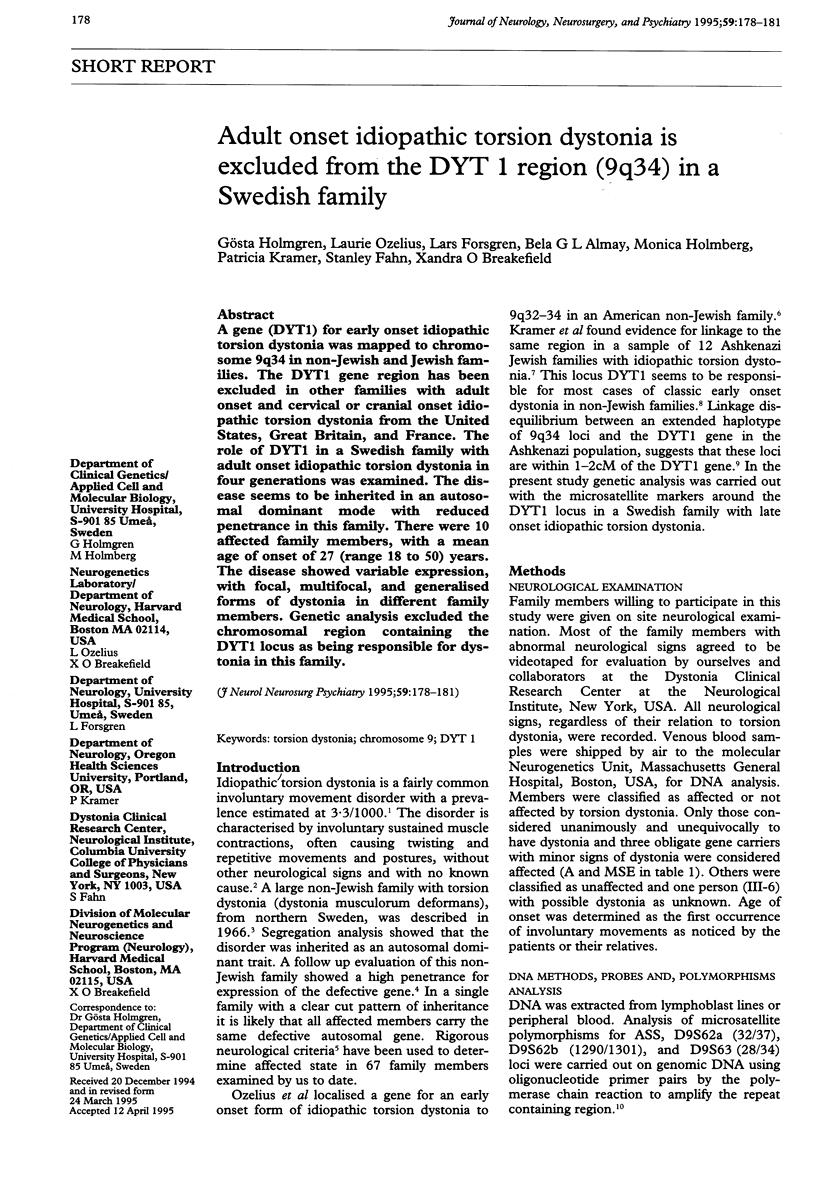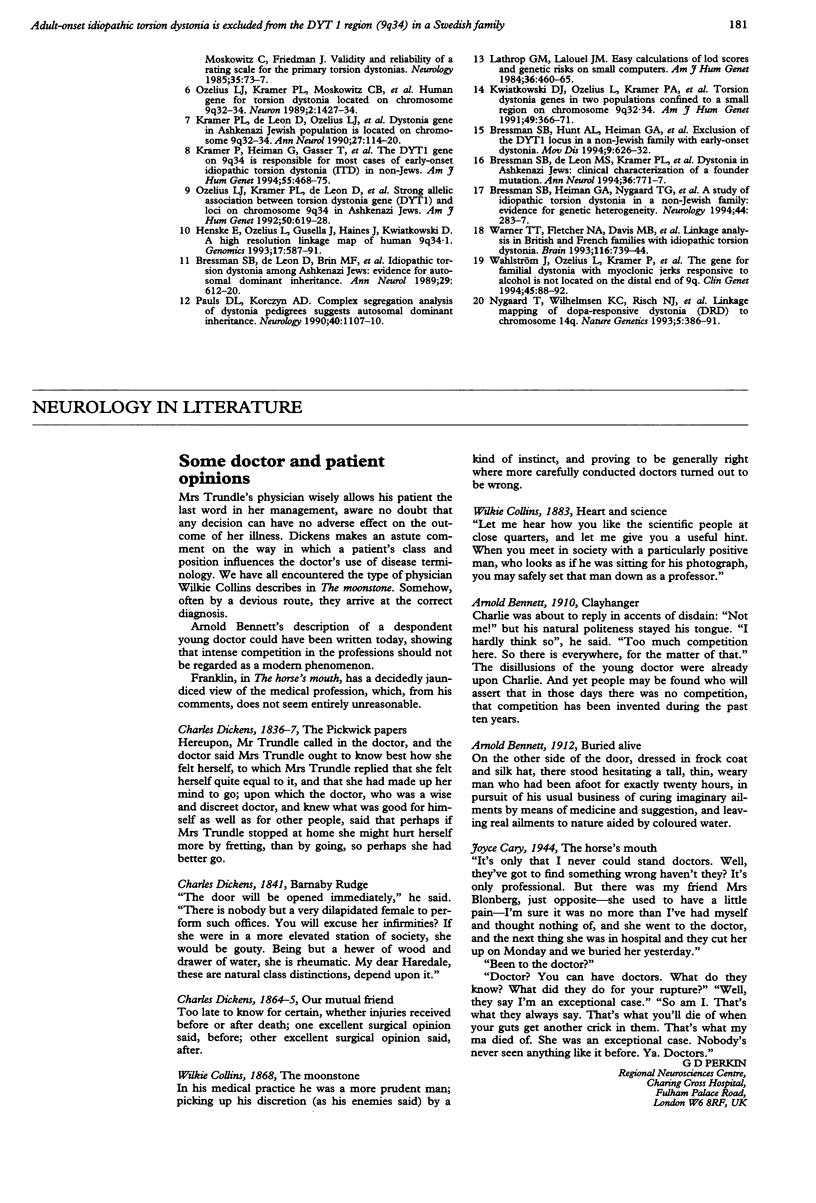Abstract
A gene (DYT1) for early onset idiopathic torsion dystonia was mapped to chromosome 9q34 in non-Jewish and Jewish families. The DYT1 gene region has been excluded in other families with adult onset and cervical or cranial onset idiopathic torsion dystonia from the United States, Great Britain, and France. The role of DYT1 in a Swedish family with adult onset idiopathic torsion dystonia in four generations was examined. The disease seems to be inherited in an autosomal dominant mode with reduced penetrance in this family. There were 10 affected family members, with a mean age of onset of 27 (range 18 to 50) years. The disease showed variable expression, with focal, multifocal, and generalised forms of dystonia in different family members. Genetic analysis excluded the chromosomal region containing the DYT1 locus as being responsible for dystonia in this family.
Full text
PDF



Selected References
These references are in PubMed. This may not be the complete list of references from this article.
- Bressman S. B., Heiman G. A., Nygaard T. G., Ozelius L. J., Hunt A. L., Brin M. F., Gordon M. F., Moskowitz C. B., de Leon D., Burke R. E. A study of idiopathic torsion dystonia in a non-Jewish family: evidence for genetic heterogeneity. Neurology. 1994 Feb;44(2):283–287. doi: 10.1212/wnl.44.2.283. [DOI] [PubMed] [Google Scholar]
- Bressman S. B., Hunt A. L., Heiman G. A., Brin M. F., Burke R. E., Fahn S., Trugman J. M., de Leon D., Kramer P. L., Wilhelmsen K. C. Exclusion of the DYT1 locus in a non-Jewish family with early-onset dystonia. Mov Disord. 1994 Nov;9(6):626–632. doi: 10.1002/mds.870090608. [DOI] [PubMed] [Google Scholar]
- Bressman S. B., de Leon D., Brin M. F., Risch N., Burke R. E., Greene P. E., Shale H., Fahn S. Idiopathic dystonia among Ashkenazi Jews: evidence for autosomal dominant inheritance. Ann Neurol. 1989 Nov;26(5):612–620. doi: 10.1002/ana.410260505. [DOI] [PubMed] [Google Scholar]
- Bressman S. B., de Leon D., Kramer P. L., Ozelius L. J., Brin M. F., Greene P. E., Fahn S., Breakefield X. O., Risch N. J. Dystonia in Ashkenazi Jews: clinical characterization of a founder mutation. Ann Neurol. 1994 Nov;36(5):771–777. doi: 10.1002/ana.410360514. [DOI] [PubMed] [Google Scholar]
- Burke R. E., Fahn S., Marsden C. D., Bressman S. B., Moskowitz C., Friedman J. Validity and reliability of a rating scale for the primary torsion dystonias. Neurology. 1985 Jan;35(1):73–77. doi: 10.1212/wnl.35.1.73. [DOI] [PubMed] [Google Scholar]
- Henske E. P., Ozelius L., Gusella J. F., Haines J. L., Kwiatkowski D. J. A high-resolution linkage map of human 9q34.1. Genomics. 1993 Sep;17(3):587–591. doi: 10.1006/geno.1993.1376. [DOI] [PubMed] [Google Scholar]
- Kramer P. L., Heiman G. A., Gasser T., Ozelius L. J., de Leon D., Brin M. F., Burke R. E., Hewett J., Hunt A. L., Moskowitz C. The DYT1 gene on 9q34 is responsible for most cases of early limb-onset idiopathic torsion dystonia in non-Jews. Am J Hum Genet. 1994 Sep;55(3):468–475. [PMC free article] [PubMed] [Google Scholar]
- Kramer P. L., de Leon D., Ozelius L., Risch N., Bressman S. B., Brin M. F., Schuback D. E., Burke R. E., Kwiatkowski D. J., Shale H. Dystonia gene in Ashkenazi Jewish population is located on chromosome 9q32-34. Ann Neurol. 1990 Feb;27(2):114–120. doi: 10.1002/ana.410270203. [DOI] [PubMed] [Google Scholar]
- Kwiatkowski D. J., Ozelius L., Kramer P. L., Perman S., Schuback D. E., Gusella J. F., Fahn S., Breakefield X. O. Torsion dystonia genes in two populations confined to a small region on chromosome 9q32-34. Am J Hum Genet. 1991 Aug;49(2):366–371. [PMC free article] [PubMed] [Google Scholar]
- Lathrop G. M., Lalouel J. M. Easy calculations of lod scores and genetic risks on small computers. Am J Hum Genet. 1984 Mar;36(2):460–465. [PMC free article] [PubMed] [Google Scholar]
- Nygaard T. G., Wilhelmsen K. C., Risch N. J., Brown D. L., Trugman J. M., Gilliam T. C., Fahn S., Weeks D. E. Linkage mapping of dopa-responsive dystonia (DRD) to chromosome 14q. Nat Genet. 1993 Dec;5(4):386–391. doi: 10.1038/ng1293-386. [DOI] [PubMed] [Google Scholar]
- Ozelius L. J., Kramer P. L., de Leon D., Risch N., Bressman S. B., Schuback D. E., Brin M. F., Kwiatkowski D. J., Burke R. E., Gusella J. F. Strong allelic association between the torsion dystonia gene (DYT1) andloci on chromosome 9q34 in Ashkenazi Jews. Am J Hum Genet. 1992 Mar;50(3):619–628. [PMC free article] [PubMed] [Google Scholar]
- Ozelius L., Kramer P. L., Moskowitz C. B., Kwiatkowski D. J., Brin M. F., Bressman S. B., Schuback D. E., Falk C. T., Risch N., de Leon D. Human gene for torsion dystonia located on chromosome 9q32-q34. Neuron. 1989 May;2(5):1427–1434. doi: 10.1016/0896-6273(89)90188-8. [DOI] [PubMed] [Google Scholar]
- Pauls D. L., Korczyn A. D. Complex segregation analysis of dystonia pedigrees suggests autosomal dominant inheritance. Neurology. 1990 Jul;40(7):1107–1110. doi: 10.1212/wnl.40.7.1107. [DOI] [PubMed] [Google Scholar]
- Wahlström J., Ozelius L., Kramer P., Kyllerman M., Schuback D., Forsgren L., Holmgren G., Drugge U., Sanner G., Fahn S. The gene for familial dystonia with myoclonic jerks responsive to alcohol is not located on the distal end of 9q. Clin Genet. 1994 Feb;45(2):88–92. doi: 10.1111/j.1399-0004.1994.tb04000.x. [DOI] [PubMed] [Google Scholar]
- Warner T. T., Fletcher N. A., Davis M. B., Ahmad F., Conway D., Feve A., Rondot P., Marsden C. D., Harding A. E. Linkage analysis in British and French families with idiopathic torsion dystonia. Brain. 1993 Jun;116(Pt 3):739–744. doi: 10.1093/brain/116.3.739. [DOI] [PubMed] [Google Scholar]


